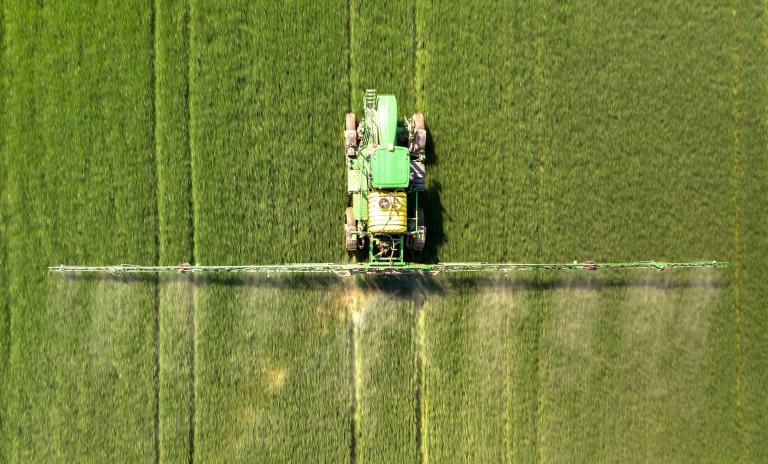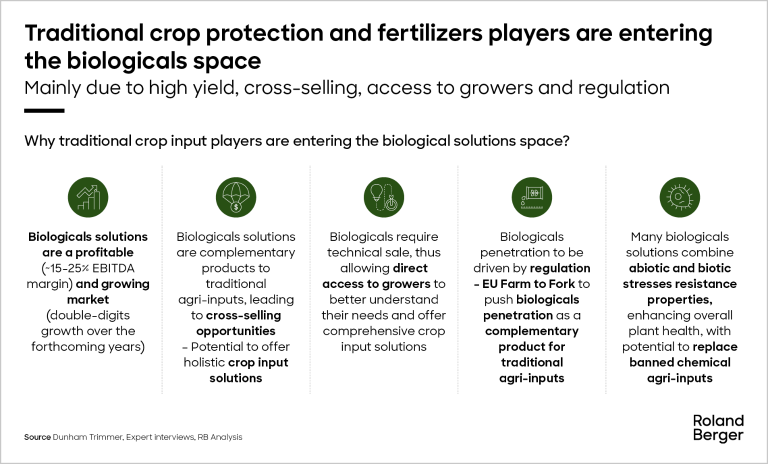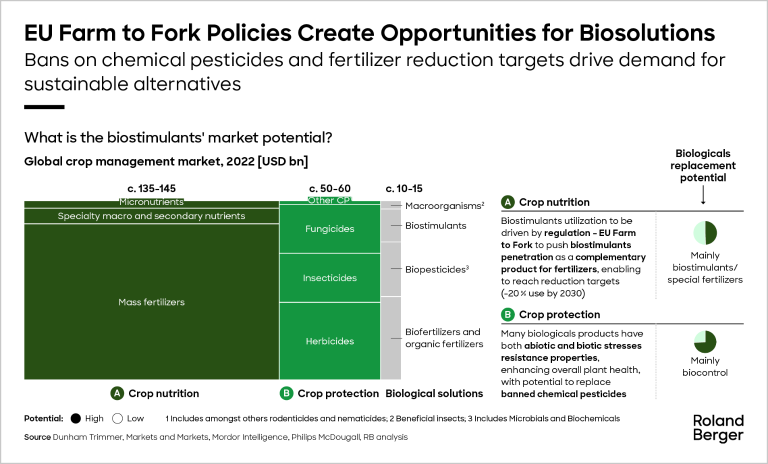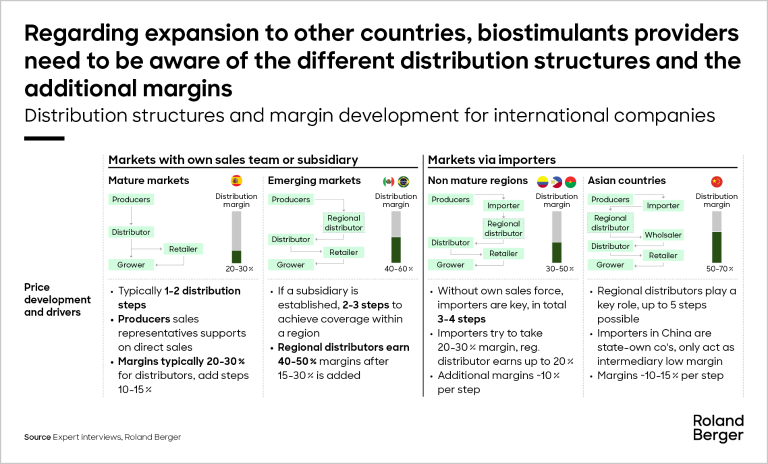Global warming, rising inflation, and limited resources are straining the global food supply. Here’s how automation and robotics can turn the tide in the farming industry, according to new Roland Berger research.


Defining a successful approach for the Spanish agri-inputs providers
How successful Spanish players tailor their strategies to thrive in the Agri-Inputs market
The Agri-inputs market comprises all products used to grow plants, ranging from basic chemical-based fertilizers and pesticides to innovative solutions such as microorganisms. The market can be segmented into two main functional categories: (i) fertilizers, which address abiotic stresses in plants; (ii) pesticides, which address biotic stresses
Both segments are heavily concentrated, with major players like Yara dominating the fertilizers market, and BASF and Bayer leading in pesticides. These markets are mature and characterized by the dominance of international players.

Despite this consolidation, there is a significant push to reduce chemical usage, leading to the emergence of increasingly innovative biological products. On one hand, biocontrol products aim to replace pesticides, while biostimulants seek to replace fertilizers. Biological products encompass a wide range of technologies, from algae extracts to microbial-based solutions.
The Agri inputs market, driven by enduring trends such as population growth, food scarcity, climate change and the consequent need to increase yield, requires strategic adaptation.
On the one hand, the urgency and complexity of increasing crops’ yield, together with regulation getting stricter on limiting the use of molecules, requires demand for new, high-yield, scalable, and sustainable technologies; on the other hand, market structure’s complexity drives the necessity for a tailored approach for success, including a customized business model for each client profile and collaboration with various intermediaries.
The resilience of the Spanish Agri-Inputs providers to be sustained with portfolio and geographical diversification
Despite recent year challenges like supply chain disruptions, inputs prices inflation , and political unrest demand for agri-inputs is expected to recover in coming years. Furthermore Spanish providers benefitted from sustained demand from local growers.
In Spain, farmers prioritize crop management inputs, demonstrating Spain's high commitment to biological innovation. Also, Spain production is heavily focused on F&V and export crops (e.g., citric, tomatoes) demonstrating higher resiliency during economic downturns.
Successful players diversify product offering on the most resilient crops, in order to be able to pass-through to final grower’s potential raw materials increase. Crops’ resiliency depending on:
- the value added per hectare
- the export share
- the number of harvesting cycles (e.g., berries and banana have the highest number of harvests per year)
- the share drip irrigation (allowing for fertigation programs).
Nevertheless, to ensure revenue stability looking forward agri-inputs providers need to diversify geographically to avoid localized complexities (e.g. bad harvests, drought, political unrest, etc.). Several Spanish providers are well position internationally and are selling in all the key growing regions globally such as LatAm, Asia, and Africa.
Develop a comprehensive portfolio strategy focused on scalable biological products
The agri-inputs market is undergoing a period of transition, driven by the demand to reduce the use of chemical pesticides and fertilizers , especially on relevant importing regions such as Europe, and North America. For instance, the EU Farm to Fork strategy aims to reduce chemical fertilizer use by 30% by 2030, and the EU Commission regularly updates the list of banned chemical pesticide molecules.
Spanish agri-inputs players must navigate this complex scenario and are striving to replace chemical products with biological alternatives. This trend is evidenced by the recent wave of mergers and acquisitions, with multinational chemical companies (e.g., BASF, Bayer) and large agri-inputs providers (e.g., UPL, Syngenta, Corteva) investing in biological companies to access innovative and scalable technologies, market knowledge, and market access for new products.
However, challenges arise as many current technologies are not yet scalable, are more expensive, less effective, and less accepted by traditional farmers. For these reasons, the market has also seen several partnerships focused on developing new products and technologies (e.g., Bayer and Kimitec in Spain collaborating on new microbial biostimulants solutions).
Successful agri-inputs players are strategically developing their product portfolios, prioritizing scalable technologies, focusing on efficacy tests, and emphasizing farmer education.
Navigating the complexity of the Agri-Inputs go-to-market regional differences
The globalized agri-inputs market includes a diverse array of participants, including importers, national wholesalers, specialized distributors, cooperatives, farm associations, and final growers. This complexity needs a tailored approach to address the varied needs across the value chain.
Additionally, crop diversity drives varying farmers' requirements and crop management issues across crops, requiring highly customized products and integrated crop management solutions with high service levels, such as application services and efficacy trials.
A successful go-to-market strategy for a Spanish player operating internationally involves the following steps:
- Analyzing farmers' current and future needs in detail by studying market trends by region to structure the offerings and services accordingly
- Carefully planning the number of intermediaries to work with and the type of distribution relationship (exclusivity vs. non-exclusivity) by region
- Deciding where, which crops and which farmers to prioritize with direct sales
"Biological solutions are becoming crucial for achieving target productivity. Microbial solutions, with their rapid growth, create a complexity that distribution must adapt to"
Preparing to deliver high service levels
- Invest in personnel training, focusing on technical, sales, and regulatory teams
- Invest in field application and trial services by adopting precision agriculture measures, using innovative testing and data monitoring technologies (e.g., drones to detect plant development stages and plant health)
- Develop integrated crop management solutions and act as a one-stop shop for specific crops, offering crop-specific products with higher efficacy and more personalized application instructions
What are the common characteristics of successful players?
All in all, Spanish successful players must focus on their product portfolio and go-to-market strategy to navigate these complexities and thrive in agri-inputs market both locally and internationally.
Regarding the product portfolio strategy, players should enhance raw material sourcing by strengthening and localizing relationships with key raw material providers. Additionally, agri inputs providers should focus on innovation by developing patented product formulations and manufacturing technologies and ensure regulatory compliance to register products in multiple geographies. Finally, they should increasingly focus on biological products to gradually replace chemical pesticides and fertilizers, prioritizing biostimulants and biocontrol microbial products.








